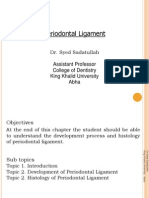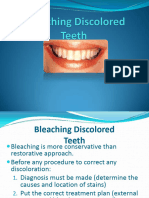Structure and Position of Tooth and Teeth (Powerpoint)
Structure and Position of Tooth and Teeth (Powerpoint)
Uploaded by
Jannin HwangCopyright:
Available Formats
Structure and Position of Tooth and Teeth (Powerpoint)
Structure and Position of Tooth and Teeth (Powerpoint)
Uploaded by
Jannin HwangOriginal Description:
Copyright
Available Formats
Share this document
Did you find this document useful?
Is this content inappropriate?
Copyright:
Available Formats
Structure and Position of Tooth and Teeth (Powerpoint)
Structure and Position of Tooth and Teeth (Powerpoint)
Uploaded by
Jannin HwangCopyright:
Available Formats
Structure of
Tooth
What is Tooth and what
does it do?
Structure of Tooth
Tooth is divided into three parts: the crown, the neck, and the root. The
crown is the visible part of the tooth above the gum. The neck is just below
the gum line. The part of the tooth that we can see is covered with enamel,
which is the hardest substance in the body. The only naturally occurring
substance harder than enamel is a diamond.
People have two sets of teeth during their life. First, they have 20 primary
teeth also called baby teeth that are usually in by age three. These fall
out, and permanent teeth starts developing around age six. By the time
people are fully-grown, they have 32 permanent teeth.
Enamel The hard outer layer of the crown. Enamel is the hardest substance in the body.
Dentine Not as hard as enamel, forms the bulk of the tooth and can be sensitive if the
protection of the enamel is lost.
Pulp Soft tissue containing the blood and nerve supply to the tooth. The pulp extends from
the crown to the tip of the root.
Cementum The layer of bone-like tissue covering the root. It is not as hard as enamel.
Structures around the tooth
Periodontal ligament: Made up of thousands of fibres which fasten the cementum to the
bony socket. These fibres anchor the tooth to the jaw bone and act as shock absorbers for
the tooth which is subjected to heavy forces during chewing.
Gingivae (gums): Soft tissue that immediately surrounds the teeth and bone. It protects the
bone and the roots of the teeth and provides an easily lubricated surface.
Bone: Provides a socket to surround and support the roots of the teeth.
Nerves and blood supply: Each tooth and periodontal ligament has a nerve supply and the
teeth are sensitive to a wide variety of stimuli. The blood supply is necessary to maintain the
vitality of the tooth.
Structure and Position of Teeth
Structure and Position of Teeth
Structure and Position of Teeth
Permanent teeth have an important role in preparing the food for use in the
body. The incisors (the sharp front teeth) cut the food, the canines or cuspids
(pointed teeth) tear the food into smaller pieces, the premolars (teeth with
double points) tear and crush the foods and the molars (the large teeth with
several rounded points) grind the food into bits.
Problems with Teeth
Tooth also called caries is usually started by the action on the outside of the
teeth of acid produced by bacteria feeding mostly on sugary foods and sweet
we eat.
This has several stages consist of a sticky film of bacteria and other microorganisms, together with materials from the saliva and foods we eat.
This is relatively easy to remove by brushing, and can be felt by the tongue.
How can we prevent Tooth Decay?
Prevention of Tooth Decay
Regular brushing with toothpaste should remove plaque, preventing decay
and the build up of calculus.
It is important to brush the teeth efficiently.
However, it is important not to overdo brushing, or else the gums may recede,
so that the cement of the roots is exposed. Toothpaste contains mildly
abrasive compound and the surfaced ay be damaged.
Mouthwashes are claimed to kill bacteria in the mouth, and therefore to
freshen the breath and preserved the teeth.
You might also like
- The Protocols of Biomimetic Restorative Dentistry - 2002 To 2017 - June 2017 - Inside DentistryDocument7 pagesThe Protocols of Biomimetic Restorative Dentistry - 2002 To 2017 - June 2017 - Inside DentistrygermanNo ratings yet
- Atlas of Oral Histology by Akramjuaim PDFDocument151 pagesAtlas of Oral Histology by Akramjuaim PDFAna Maria Hernandez Ardila100% (1)
- Development of Face and AnomaliesDocument69 pagesDevelopment of Face and AnomaliesgoksdentNo ratings yet
- EMBRASURESDocument1 pageEMBRASURESGauri100% (1)
- Alveolar BoneDocument78 pagesAlveolar BoneHarleen GrewalNo ratings yet
- Development of TeethDocument30 pagesDevelopment of TeethsiyaNo ratings yet
- Oral Histology - NEET MDSDocument6 pagesOral Histology - NEET MDSdrpnnreddyNo ratings yet
- Tooth Eruption and SheddingDocument29 pagesTooth Eruption and Sheddingjenny girl100% (1)
- 6 - Eruption, Shedding and Maxillary Sinus (Mahmoud Bakr)Document136 pages6 - Eruption, Shedding and Maxillary Sinus (Mahmoud Bakr)Mobarobber100% (2)
- 1 Introduction of Operative DentistryDocument18 pages1 Introduction of Operative Dentistryahmedfawakh0No ratings yet
- Amelogenesis Imperfecta FinalDocument8 pagesAmelogenesis Imperfecta FinalAbdullah Muhammed khaleel HassanNo ratings yet
- EruptionDocument18 pagesEruptionAnamika PandeyNo ratings yet
- EnamelDocument32 pagesEnamelMohammed hisham khanNo ratings yet
- Chapter 3 - Anatomy, Physiology (Essentials of Dental Assisting)Document35 pagesChapter 3 - Anatomy, Physiology (Essentials of Dental Assisting)mussanteNo ratings yet
- 3D Teeth ReconstructionDocument0 pages3D Teeth ReconstructionSamir Alberita KeljmendiNo ratings yet
- Theories of Dental CariesDocument28 pagesTheories of Dental CariesJewel VirataNo ratings yet
- The Anatomy of The Tooth WORKSHEETDocument4 pagesThe Anatomy of The Tooth WORKSHEETAndaNo ratings yet
- Bleeding Disorders: Presented by Janani RGDocument43 pagesBleeding Disorders: Presented by Janani RGJanani GopalakrishnanNo ratings yet
- 1-Eruption of TeethDocument9 pages1-Eruption of TeethAhmed AbdNo ratings yet
- Brochure-Gc Fuji ViiDocument16 pagesBrochure-Gc Fuji ViiZulfahmi NurdinNo ratings yet
- Preprosthetic Surgery 12-02-015Document32 pagesPreprosthetic Surgery 12-02-015Yaser JasNo ratings yet
- PerioDontal LigamentDocument18 pagesPerioDontal LigamentDENTALORG.COMNo ratings yet
- Periodontal LigamentDocument56 pagesPeriodontal LigamentDent DealsNo ratings yet
- Oral HistologyDocument6 pagesOral HistologyMr. Orange100% (2)
- Composite Vs Amalgam PowerpointDocument17 pagesComposite Vs Amalgam Powerpointapi-322463366100% (1)
- Oral Health PromotionDocument11 pagesOral Health PromotionIGN 1SNo ratings yet
- 1 EnamelDocument40 pages1 EnamelHarshvardhanNo ratings yet
- Role of Radiographs in Pdl. DiseaseDocument71 pagesRole of Radiographs in Pdl. DiseaseDrKrishna Das0% (1)
- Tooth MorphologyDocument53 pagesTooth Morphologyziaullahafridi657No ratings yet
- CDE Fundamentals - in - Tooth - Preparation 16 12 14Document87 pagesCDE Fundamentals - in - Tooth - Preparation 16 12 14Saad khanNo ratings yet
- Cysts of The Jaws & Oral Cavity: R V SubramanyamDocument3 pagesCysts of The Jaws & Oral Cavity: R V SubramanyamFaraz MohammedNo ratings yet
- Glass Ionomer Cement PolyalkenoatesDocument26 pagesGlass Ionomer Cement PolyalkenoatesArifa parveenNo ratings yet
- Lecture 13 - Extraction of ToothDocument46 pagesLecture 13 - Extraction of Toothvanesa AvramovaNo ratings yet
- JdsmcxnksDocument32 pagesJdsmcxnksBibek RajNo ratings yet
- Dental AnatomyDocument25 pagesDental AnatomyCésar Heleno100% (1)
- Mandibular Central IncisorDocument19 pagesMandibular Central IncisorDR. ISHITA SINGHAL100% (1)
- Periodontium (4) : Periodontal LigamentsDocument6 pagesPeriodontium (4) : Periodontal Ligamentsمحمد محمود القحيفNo ratings yet
- BDS 5 Exam papersVCDocument8 pagesBDS 5 Exam papersVCsags_3No ratings yet
- Noma Cancrum Oris Gangrenous GingivitisDocument3 pagesNoma Cancrum Oris Gangrenous GingivitisSuprit Sn100% (2)
- Al Rafidain Universiy College of DentistryDocument23 pagesAl Rafidain Universiy College of DentistrymahmoodNo ratings yet
- Immunology Dental Caries-2015Document24 pagesImmunology Dental Caries-2015Bagus Rahmawan50% (2)
- Acute Gingival Infection Lecture - pdf-1251132185Document68 pagesAcute Gingival Infection Lecture - pdf-1251132185irajput 001No ratings yet
- Tooth Numbering SystemDocument28 pagesTooth Numbering SystemMoona WahabNo ratings yet
- Geometric Outlines and Physiological Form of The Teeth and FunctionsDocument24 pagesGeometric Outlines and Physiological Form of The Teeth and FunctionsDina Yasser100% (1)
- OsteomyelitisDocument10 pagesOsteomyelitismustafaNo ratings yet
- Class I Compound CavityDocument79 pagesClass I Compound CavityShahid HameedNo ratings yet
- How To Construct High Quality MCQDocument10 pagesHow To Construct High Quality MCQVaidya Omprakash NarayanNo ratings yet
- Oral Submucous FibrosisDocument5 pagesOral Submucous Fibrosiskunnuve5005100% (1)
- Saliva and Dental CariesDocument23 pagesSaliva and Dental CariesKhalid MortajaNo ratings yet
- Eruption of The TeethDocument15 pagesEruption of The TeethElena CristinaNo ratings yet
- Seminar15 Mid 180118092933Document89 pagesSeminar15 Mid 180118092933Aditee AgrawalNo ratings yet
- Class III Cavity Preparation DR TalhaDocument26 pagesClass III Cavity Preparation DR TalhaFatima SiddiquiNo ratings yet
- Maxillary SinusDocument25 pagesMaxillary Sinusshreya dasNo ratings yet
- EnamelDocument11 pagesEnamel3ezzat100% (1)
- Early Childhood CariesDocument20 pagesEarly Childhood CariesIfata RDNo ratings yet
- Mandibular IncisorsDocument13 pagesMandibular IncisorsVishal PatelNo ratings yet
- Stem CellDocument17 pagesStem Cellsonal agarwalNo ratings yet
- DentinDocument89 pagesDentinDr Zadeno kithanNo ratings yet
- Teeth: Now Smile PLZDocument13 pagesTeeth: Now Smile PLZUsama FarooqNo ratings yet
- Dental Anatomy Teeth Types and Diff Basic TerminologyDocument73 pagesDental Anatomy Teeth Types and Diff Basic Terminologymakondotakunda11No ratings yet
- Anatomy TeethDocument74 pagesAnatomy Teethmakondotakunda11No ratings yet
- Oral Histolgy: Type of DentinDocument5 pagesOral Histolgy: Type of DentinAli HayderNo ratings yet
- HeliobondDocument36 pagesHeliobondNg JunnNo ratings yet
- Abrasiveness of Dental CeramicsDocument15 pagesAbrasiveness of Dental CeramicsHarish KhundrakpamNo ratings yet
- Recording Structure of MammalsDocument334 pagesRecording Structure of Mammalsfransiskus.rada24No ratings yet
- Analysis of Enamel Rod End Pattern For Personal IdentificationDocument6 pagesAnalysis of Enamel Rod End Pattern For Personal IdentificationNaneunBaboNo ratings yet
- Daftar Pustaka R8Document3 pagesDaftar Pustaka R8Reza Irian RamaNo ratings yet
- CBSE Class 4 Social Studies Worksheet PDFDocument35 pagesCBSE Class 4 Social Studies Worksheet PDFRakesh AgarwalNo ratings yet
- Histological Preparation of Teeth and Tooth GrowthDocument6 pagesHistological Preparation of Teeth and Tooth Growthananda apryliaNo ratings yet
- Laminate VeneersDocument93 pagesLaminate VeneersSandeep Reddy91% (11)
- Ceramic LaminateDocument13 pagesCeramic LaminatePadmini ReddyNo ratings yet
- Measuring Dental FluorosisDocument18 pagesMeasuring Dental FluorosisQazi ShahmeerNo ratings yet
- Treze Anos de Acompanhamento Clínico de Restaurações Conservativas de Resina Composta No Fechamento de Diastemas AnterioresDocument5 pagesTreze Anos de Acompanhamento Clínico de Restaurações Conservativas de Resina Composta No Fechamento de Diastemas AnterioresMuchlis Fauzi ENo ratings yet
- Cosmetic Recontouring PDFDocument13 pagesCosmetic Recontouring PDFVladislava Ganeva100% (1)
- Tooth Decay Easy Read GuideDocument29 pagesTooth Decay Easy Read GuideSTEM JordanNo ratings yet
- Effect of Orthodontic Sealant Containing Antimicrobial Selenium On The Shear Bond Strength of Orthodontic BracketDocument5 pagesEffect of Orthodontic Sealant Containing Antimicrobial Selenium On The Shear Bond Strength of Orthodontic BracketanantomiNo ratings yet
- BleachingDocument62 pagesBleachingوردة صبرNo ratings yet
- 2023 Mechanical Digestion and ACDocument23 pages2023 Mechanical Digestion and ACwengielovaNo ratings yet
- The "Index Technique" in Worn Dentition: A New and Conservative ApproachDocument32 pagesThe "Index Technique" in Worn Dentition: A New and Conservative ApproachHektor Hak100% (1)
- CariesDocument99 pagesCariesKaran Arora100% (1)
- Minimal Intervention Dentistry in General Dentistry PDFDocument10 pagesMinimal Intervention Dentistry in General Dentistry PDFmostafahassan777No ratings yet
- Enamel: Physical CharacteristicsDocument11 pagesEnamel: Physical CharacteristicsAthiya SultanaNo ratings yet
- Oral Pathology Lec - 1Document25 pagesOral Pathology Lec - 1مصطفى محمدNo ratings yet
- CarteDocument272 pagesCarteClaudia MoldovanuNo ratings yet
- Panchagavya Black Tooth Powder Is All You Need For All Your Dental ProblemsDocument4 pagesPanchagavya Black Tooth Powder Is All You Need For All Your Dental ProblemsChandra Sekhar GajulaNo ratings yet
- Dentinogenesis (AuthorV Mazuru)Document40 pagesDentinogenesis (AuthorV Mazuru)Octavian DavidsonNo ratings yet
- Data Pembimbing Dan Judul Seminar ODDocument5 pagesData Pembimbing Dan Judul Seminar ODAyu PujiwatiNo ratings yet
- Composite ResinDocument46 pagesComposite Resintj_sweetgirl100% (1)
- Int J Esthet Dent 2014 Magne PDFDocument17 pagesInt J Esthet Dent 2014 Magne PDFVanessa Patiño Bautista100% (1)
- Class I Amalgam Cavity Preparation: Dr. Noura ShonoDocument43 pagesClass I Amalgam Cavity Preparation: Dr. Noura ShonoASHWINI ATHULNo ratings yet

























































































